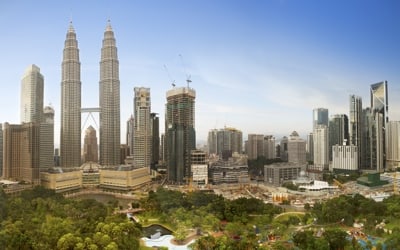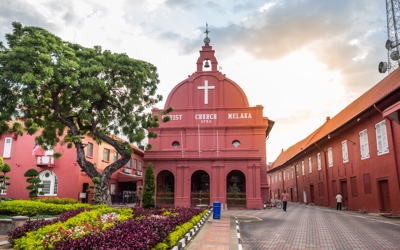
Batu Caves Tour from Kuala Lumpur
2 h
Instant confirmation
About this activity
Itinerary
This is a typical itinerary for this product
Stop At: Gombak, Batu Caves 68100 Malaysia
Batu Caves is an iconic and popular tourist attraction in Selangor.
Site of a Hindu temple and shrine, Batu Caves attracts thousands of worshippers and tourists, especially during the annual Hindu festival, Thaipusam.
A limestone outcrop located just north of Kuala Lumpur, Batu Caves has three main caves featuring temples and Hindu shrines.
Its main attraction is the large statue of the Hindu God at the entrance, besides a steep 272 climb up its steps to finally view the stunning skyline of the city centre.
Monkeys frolic around the caves, and it is a popular spot for rock climbing enthusiasts. Paintings and scenes of Hindu Gods can also be seen in the Ramayana Cave.
Batu Caves is a place where you should not miss on your visit.
Batu Caves is a limestone hill, which has a series of caves and cave temples, located in Gombak district, 13 kilometres (8 miles) north of Kuala Lumpur, Malaysia. It takes its name from the Sungai Batu or Batu River, which flows past the hill. Batu Caves is also the name of the nearby village.
Batu Caves is one of the most popular Hindu shrines outside India, dedicated to Lord Murugan. It is the focal point of Hindu festival of Thaipusam in Malaysia. It is also known as the 10th Caves or Hill for Lord Muruga as it is one of the ten most important shrines in India and Malaysia. The Lord Murugan statue at the foot of Batu Caves is the second tallest Hindu deity statue in the world with a heroic height of 42.7 metres (140 ft.).
History
The limestone forming Batu Caves is said to be around 400 million years old. Some of the cave entrances were used as shelters by the aboriginal Temuan / Besisi people (a tribe of Orang Asli). As early as 1860, Chinese settlers began excavating guano for fertilising their vegetable patches. However, they became famous only after the limestone hills were recorded by colonial authorities including Daly and Syers as well as American Naturalist, William Hornaday in 1878.
Batu Caves was promoted as a place of worship by K. Thamboosamy Pillai, an Indian trader. He was inspired by the ‘vel’-shaped entrance of the main cave and was inspired to dedicate a temple to Lord Muruga within the caves. In temples dedicated to Lord Murugan, Vel, a divine javelin (spear), is an object of worship.
The history of Batu Caves started in 1891 when Mr. K. Thamboosamy Pillai, who also founded the Sri Maha Mariamman Temple Dhevasthanam, Kuala Lumpur, sent his very close associates, Sri Thiruvengadam Pillai and Sri Kanthapa Thevar to survey for an ideal and suitable place of worship for Lord Sri Murugan.
It was in that year, that the influential descendant of Indian immigrants from Tamil Nadu, India, Mr. K. Thamboosamy Pillai installed the ‘murti’ or consecrated idol of Sri Subramaniar Swamy (Lord Murugan) in the 400-ft. high Temple Cave. From 1892 onwards, the Thaipusam festival in the Tamil month of Thai (which falls in late January/early February) has been celebrated there as the annual festival of Batu Caves. Wooden steps up to the Temple Cave were built in 1920 and have since been replaced by 272 concrete steps.
Rising almost 100 m above the ground, the Batu Caves temple complex consists of three main caves and a few smaller ones. The biggest, referred to as Cathedral Cave or Temple Cave, has a 100 m-high ceiling and features ornate Hindu shrines. To reach it, visitors must climb a precipitous flight of 272 steps.
At the base of the hill are two more cave temples, Art Gallery Cave and Museum Cave, both of which are full of Hindu statues and paintings. This complex was renovated and established as the Cave Villa in 2008. The story of Lord Murugan’s victory over the demon Soorapadam is narrated by many of the shrines. An audio tour is available to visitors.
To the utmost left, as one faces the steep wall of the hill, stands the Ramayana Cave. The Ramayana Cave depicts the story of Rama in a chronicle manner along the irregular walls of the cave. On the way to the Ramayana Cave, there is a 50-foot (15 m) tall statue of Hanuman and a temple dedicated to Hanuman, the noble monkey devotee and aide of Lord Rama. The declaration ceremony of the temple was held in November 2001.
Duration: 2 hours
Read more
Show less
This is a typical itinerary for this product
Stop At: Gombak, Batu Caves 68100 Malaysia
Batu Caves is an iconic and popular tourist attraction in Selangor.
Site of a Hindu temple and shrine, Batu Caves attracts thousands of worshippers and tourists, especially during the annual Hindu festival, Thaipusam.
A limestone outcrop located just north of Kuala Lumpur, Batu Caves has three main caves featuring temples and Hindu shrines.
Its main attraction is the large statue of the Hindu God at the entrance, besides a steep 272 climb up its steps to finally view the stunning skyline of the city centre.
Monkeys frolic around the caves, and it is a popular spot for rock climbing enthusiasts. Paintings and scenes of Hindu Gods can also be seen in the Ramayana Cave.
Batu Caves is a place where you should not miss on your visit.
Batu Caves is a limestone hill, which has a series of caves and cave temples, located in Gombak district, 13 kilometres (8 miles) north of Kuala Lumpur, Malaysia. It takes its name from the Sungai Batu or Batu River, which flows past the hill. Batu Caves is also the name of the nearby village.
Batu Caves is one of the most popular Hindu shrines outside India, dedicated to Lord Murugan. It is the focal point of Hindu festival of Thaipusam in Malaysia. It is also known as the 10th Caves or Hill for Lord Muruga as it is one of the ten most important shrines in India and Malaysia. The Lord Murugan statue at the foot of Batu Caves is the second tallest Hindu deity statue in the world with a heroic height of 42.7 metres (140 ft.).
History
The limestone forming Batu Caves is said to be around 400 million years old. Some of the cave entrances were used as shelters by the aboriginal Temuan / Besisi people (a tribe of Orang Asli). As early as 1860, Chinese settlers began excavating guano for fertilising their vegetable patches. However, they became famous only after the limestone hills were recorded by colonial authorities including Daly and Syers as well as American Naturalist, William Hornaday in 1878.
Batu Caves was promoted as a place of worship by K. Thamboosamy Pillai, an Indian trader. He was inspired by the ‘vel’-shaped entrance of the main cave and was inspired to dedicate a temple to Lord Muruga within the caves. In temples dedicated to Lord Murugan, Vel, a divine javelin (spear), is an object of worship.
The history of Batu Caves started in 1891 when Mr. K. Thamboosamy Pillai, who also founded the Sri Maha Mariamman Temple Dhevasthanam, Kuala Lumpur, sent his very close associates, Sri Thiruvengadam Pillai and Sri Kanthapa Thevar to survey for an ideal and suitable place of worship for Lord Sri Murugan.
It was in that year, that the influential descendant of Indian immigrants from Tamil Nadu, India, Mr. K. Thamboosamy Pillai installed the ‘murti’ or consecrated idol of Sri Subramaniar Swamy (Lord Murugan) in the 400-ft. high Temple Cave. From 1892 onwards, the Thaipusam festival in the Tamil month of Thai (which falls in late January/early February) has been celebrated there as the annual festival of Batu Caves. Wooden steps up to the Temple Cave were built in 1920 and have since been replaced by 272 concrete steps.
Rising almost 100 m above the ground, the Batu Caves temple complex consists of three main caves and a few smaller ones. The biggest, referred to as Cathedral Cave or Temple Cave, has a 100 m-high ceiling and features ornate Hindu shrines. To reach it, visitors must climb a precipitous flight of 272 steps.
At the base of the hill are two more cave temples, Art Gallery Cave and Museum Cave, both of which are full of Hindu statues and paintings. This complex was renovated and established as the Cave Villa in 2008. The story of Lord Murugan’s victory over the demon Soorapadam is narrated by many of the shrines. An audio tour is available to visitors.
To the utmost left, as one faces the steep wall of the hill, stands the Ramayana Cave. The Ramayana Cave depicts the story of Rama in a chronicle manner along the irregular walls of the cave. On the way to the Ramayana Cave, there is a 50-foot (15 m) tall statue of Hanuman and a temple dedicated to Hanuman, the noble monkey devotee and aide of Lord Rama. The declaration ceremony of the temple was held in November 2001.
Duration: 2 hours
Included
- Air-conditioned vehicle with English-Speaking Driver
- Hotel Pick-up & Drop-off
Not included
- Food and drinks, unless specified
Additional
- Confirmation will be received at time of booking
- Not wheelchair accessible
- Stroller accessible
- Infants must sit on laps
- Most travelers can participate
- This is a private tour/activity. Only your group will participate
Features
Tourism
85%
Cultural
65%
Original
50%
Adrenaline
20%
You may also like









 See all 20 Collections
See all 20 Collections
Click to discover other experiences
See all

Collections
City Orientation Tour
75 Activities

Collections
KL Tower
22 Activities

Collections
Petronas Towers
24 Activities

Collections
Batu Caves
68 Activities

Collections
Elephant Sanctuary
10 Activities

Collections
Historical Malacca
21 Activities

Collections
By Night
27 Activities

Collections
Gourmet
19 Activities

Collections
Firefly Watching
29 Activities

Collections
Boat Cruise
22 Activities

